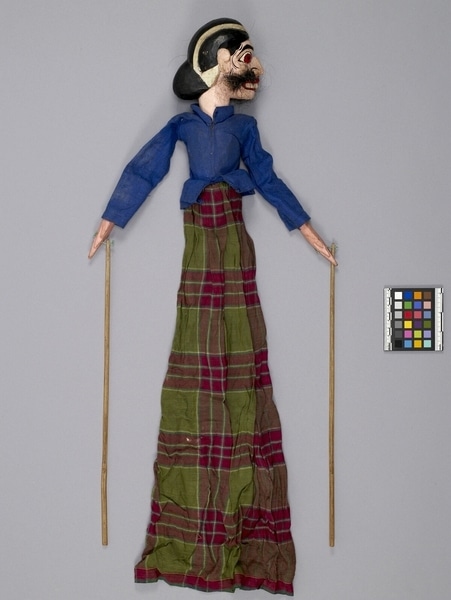Rod Puppet Item Number: Ib334 a-c from the MOA: University of British Columbia


Description
Three-dimensional male humanoid puppet: large head (part b) fits into body with skirt (part a), and a control rod (part c) with a long shaft that passes through the body and fits into the neck of the figure's head. The body has jointed arms, each with a long controlling rod attached. The figure has a light red face, blunt nose, large red eyes, red lips, and a brown human hair moustache attached to face with four bent nails. Wrinkles are rendered in black, and the figure's black hair is tied back with a white band. Clothing: blue tutupan attached with two nails, and a red, green and yellow sarong.
History Of Use
Javanese puppetry as an art form probably developed by the 11th century. The three-dimensional wooden wayang golek puppets of western Java appeared during the 16th century. Originally the plays depicted Javanese mythology, but after the Indian conquest of Java the Hindu epics, Ramayana and Mahabharata, were incorporated into the cycles, which comprise about 200 plays. An individual or group hires a dalang (puppet-master) to celebrate important occasions. The performances often last all night and are generally presented in three acts, with vocal and instrumental accompaniment. The individual plays vary widely in detail but usually involve conflict between good and evil. They serve a moral and religious purpose, and more recently, one of political commentary. Each puppet's character is represented by its appearance and placement onstage; protagonists with strong elements of good are placed to the right, antagonists of violent or evil nature to the left. Narada appears with the gods in the relevant parts of the play. The main Hindu gods do not normally appear in the plays, but use a group of lesser deities as agents. These deities or resi can appear in retinues on either side of the stage, although this does not necessarily represent their alignment. Narada provides information to protagonists not otherwise available.
Cultural Context
Theatrical performance.
Iconographic Meaning
Light red face, blunt nose, large eyes and moustache are characteristics of god, Betara Narada. He is always completely dressed. Narada is a cousin of Shiva and the son of Betara Drema and Dewi Laksmi. He has supernatural powers which he exercises as a messenger for the gods. His home is the realm of Suralaja, 'the world between,' where the gods dwell.
Item History
- Made in Java, Indonesia
- Owned by Tradewind Antiques before March 15, 1983
- Received from Museum of Anthropology Shop Volunteers (Funding source) and Tradewind Antiques (Seller) on March 15, 1983
What
- Name
- Rod Puppet
- Identification Number
- Ib334 a-c
- Type of Item
- puppet
- Material
- wood, cotton fibre, fibre, hair, metal and paint
- Manufacturing Technique
- carved, machine woven, painted, sewn, nailed and tied
- Part A
- height 61.0 cm, width 16.0 cm, depth 6.5 cm
- Part B
- height 14.0 cm, width 8.0 cm, depth 11.5 cm
- Part C
- height 34.0 cm, diameter 1.6 cm
Who
- Culture
- Sundanese
- Previous Owner
- Tradewind Antiques
- Received from
- Museum of Anthropology Shop Volunteers (Funding source) and Tradewind Antiques (Seller)
Where
- Holding Institution
- MOA: University of British Columbia
- Made in
- Java, Indonesia
When
- Ownership Date
- before March 15, 1983
- Acquisition Date
- on March 15, 1983
Other
- Condition
- fair
- Accession Number
- 0886/0068 a-c